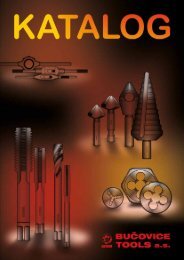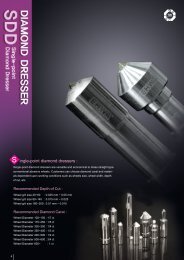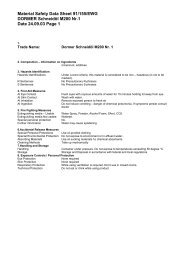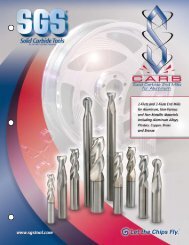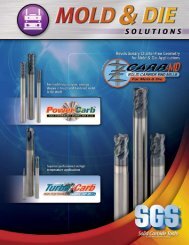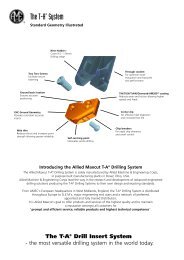Pages • Multi-Mat® Concept • Lamina Multi-Mat® full ... - Tikontools
Pages • Multi-Mat® Concept • Lamina Multi-Mat® full ... - Tikontools
Pages • Multi-Mat® Concept • Lamina Multi-Mat® full ... - Tikontools
You also want an ePaper? Increase the reach of your titles
YUMPU automatically turns print PDFs into web optimized ePapers that Google loves.
Turning Milling<br />
Cutting<br />
speed<br />
m/min<br />
Rotation<br />
Rev/min<br />
Chip Removal<br />
Rate<br />
3<br />
cm /min<br />
Cutting<br />
time<br />
in min<br />
Surface<br />
roughness<br />
um<br />
Symbol Designation Unit<br />
Dm<br />
f<br />
lm<br />
n<br />
Q<br />
Amax<br />
r<br />
Tc<br />
3<br />
Machining diameter<br />
Feed<br />
Machining length<br />
Rotation<br />
Chip Removal Rate<br />
d.o.c x feed<br />
Nose radius<br />
Cutting time<br />
Vc =<br />
n =<br />
D m x J x n<br />
1000<br />
V c x 1000<br />
Dm x J<br />
Q = Vc x ap x f<br />
Tc =<br />
Rmax =<br />
lm<br />
f x n<br />
f 2x<br />
n<br />
x 125<br />
r<br />
3<br />
mm<br />
mm<br />
mm<br />
rev/min<br />
3<br />
cm /min<br />
mm<br />
mm<br />
min<br />
2<br />
Technical Formulas<br />
Cutting<br />
speed<br />
m/min<br />
Rotation<br />
Rev/min<br />
Table feed<br />
mm/min<br />
Cutting<br />
output<br />
3 cm / min<br />
Feed<br />
per<br />
rotation<br />
Symbol Designation Unit<br />
Vc<br />
ap<br />
ae<br />
D<br />
fz<br />
K<br />
Vf<br />
Z<br />
Cutting speed<br />
Depth of cut<br />
Radial depth of cut<br />
Cutter diameter<br />
Feed per tooth<br />
Feed rate<br />
Number of teeth<br />
®<br />
Vc =<br />
n =<br />
n x J x D<br />
1000<br />
V c x 1000<br />
J x D<br />
Vf = n x z x fz<br />
Vf = n x K x fz<br />
Q =<br />
f = Z x fz<br />
f = K x fz<br />
ae x ap x Vf<br />
1000<br />
m/min<br />
mm<br />
mm<br />
mm<br />
mm/tooth<br />
Actual number of teeth for calculation<br />
feed rate of feed per revolution.<br />
mm/min<br />
No.<br />
Frequently Asked Questions<br />
Is it true that <strong>Lamina</strong> inserts can really be run in<br />
any type of work-piece material?<br />
<strong>Lamina</strong> inserts have been run on thousands of jobs<br />
the world over and will work practically any type of<br />
turning or milling metal cutting operation. Please<br />
note that, while <strong>Lamina</strong> inserts will work in Aluminium<br />
– often production jobs in Aluminium will require<br />
inserts with a geometry designed specifically for the<br />
chip control needed with Aluminium. Please see<br />
<strong>Lamina</strong> Alu-Line.<br />
What speeds and feeds should <strong>Lamina</strong> inserts be<br />
run at?<br />
Adjacent to each insert ordering info page in this<br />
catalogue, are specific data recommendations for<br />
each individual insert showing the speeds and feeds<br />
for almost every material group. In order to get the<br />
maximum benefit from <strong>Lamina</strong>’s grade technology it<br />
is important to always run the inserts at the<br />
recommended cutting data. In general – the best<br />
results are normally found at the higher end of cutting<br />
speeds shown.<br />
Will <strong>Lamina</strong> grades actually run better than the<br />
hundreds of specialized “dedicated” grades<br />
available from other suppliers?<br />
<strong>Lamina</strong> has extensive know-how in sub-micron<br />
powder technology as well as in sophisticated PVD<br />
coatings. This know-how combines with chip breaker<br />
geometry and application knowledge in order to<br />
perfect our world class offering. Customers that<br />
machine at the high performance speeds and feeds<br />
we recommend – and use sound machining<br />
techniques – continually reports superior results, in<br />
virtually all materials, and are able to replace the<br />
hundreds of confusing insert choices they previously<br />
used.<br />
Even in the applications where a <strong>Lamina</strong> insert runs<br />
“about the same” as the existing insert – the <strong>Lamina</strong><br />
solution is still a better choice – because the same<br />
<strong>Lamina</strong> insert can be used on the next job and the job<br />
after that, and so forth. That’s the <strong>Lamina</strong> <strong>Multi</strong>-Mat<br />
technology advantage.<br />
What can we expect regarding the quality and<br />
consistency of <strong>Lamina</strong> inserts?<br />
Due to <strong>Lamina</strong>’s unique production methods and<br />
Quality Control processes, you should expect inserts<br />
with much higher accuracy than you are used to. You<br />
can also expect inserts with maximum consistency<br />
from edge to edge, insert to insert, box to box and<br />
batch to batch – which offers you the ability to<br />
maximize unattended operation of your machines.<br />
What percentage of my indexable tooling<br />
requirements can <strong>Lamina</strong> supply?<br />
For most typical shops, <strong>Lamina</strong>’s insert program should<br />
cover about 80% of all inserts needed for CNC<br />
machines from 20 Hp and down. The insert program<br />
covers a <strong>full</strong> range of standard turning and milling<br />
operations from finishing up to and including medium<br />
roughing.<br />
In shops that run <strong>Lamina</strong> inserts now – what do<br />
they find are the biggest benefit<br />
- Ability to always have the right insert available<br />
immediately when they need it.<br />
- Tremendous savings in the cost of specifying inserts,<br />
ordering processes, and stocking procedures.<br />
- Simplicity and efficiency of being able to attack the<br />
job knowing that there is no longer a need to worry<br />
about having the right grade of insert.<br />
- Machinists become very familiar with the grade<br />
performance and application and are able to use the<br />
inserts to their maximum usable life.<br />
Are <strong>Lamina</strong> inserts coated the same as other PVD<br />
inserts?<br />
<strong>Lamina</strong>’s unique PVD coating has significant<br />
differences compared to normal PVD coating used on<br />
other inserts. The <strong>Lamina</strong> coating process impacts a<br />
much stronger coating – with far better adhesion –<br />
which results in the ability to machine at higher<br />
speeds, with longer tool life, and in the widest variety<br />
of materials.<br />
What about turning tool holders and boring<br />
bars?<br />
<strong>Lamina</strong>’s ANSI / ISO standard turning inserts are<br />
designed to fit all industry standard turning tools<br />
and boring bars – so you can keep on using the<br />
holders you have already invested in.<br />
In turning – when should I use the _NMP style<br />
inserts compared to the _NMG style inserts?<br />
Most customers find that high-Positive _NMP style<br />
inserts (CNMP, TNMP and WNMP) deliver the best<br />
result in materials with high heat and corrosion<br />
resistant properties. Typical materials in these<br />
categories are 300 Series Stainless steels, Inconels,<br />
and Titanium. The free cutting action of _NMP<br />
inserts offers lower cutting forces and reduces the<br />
work hardening effect.<br />
8 9



